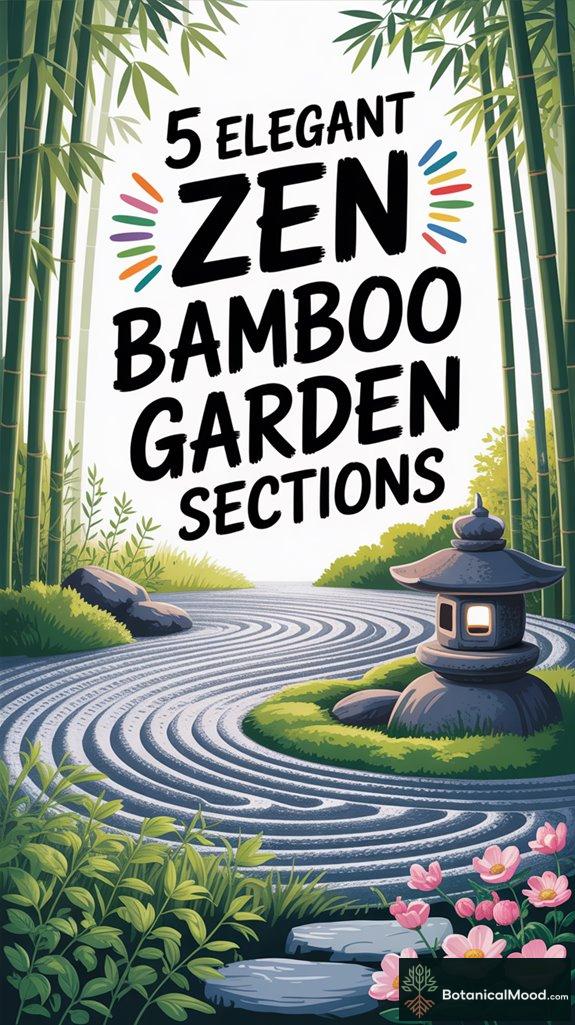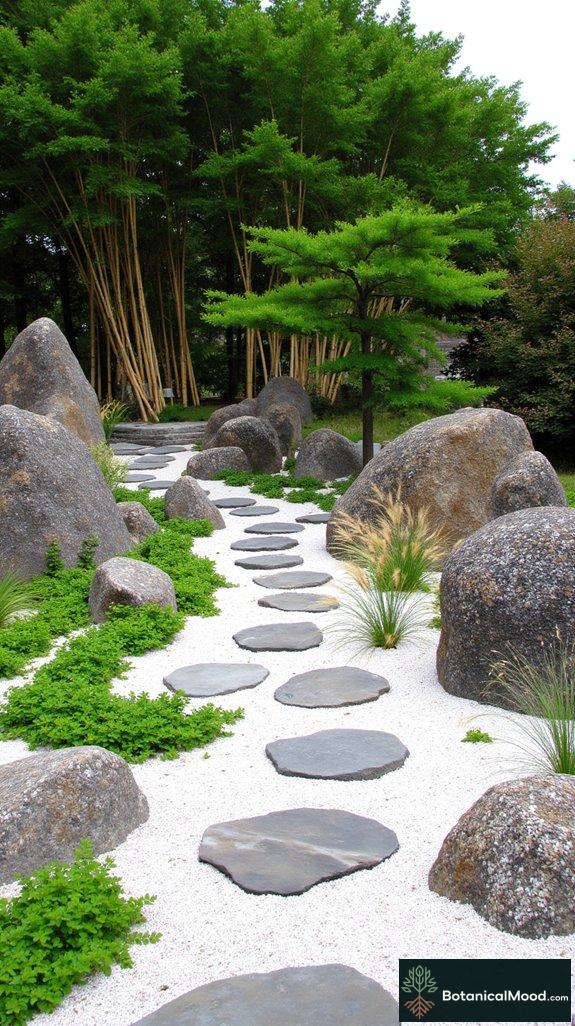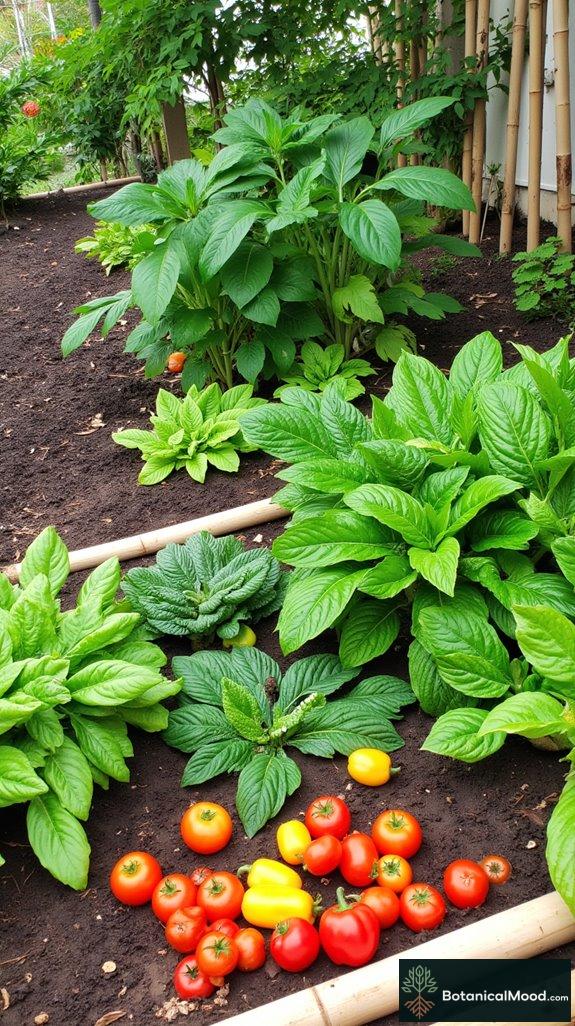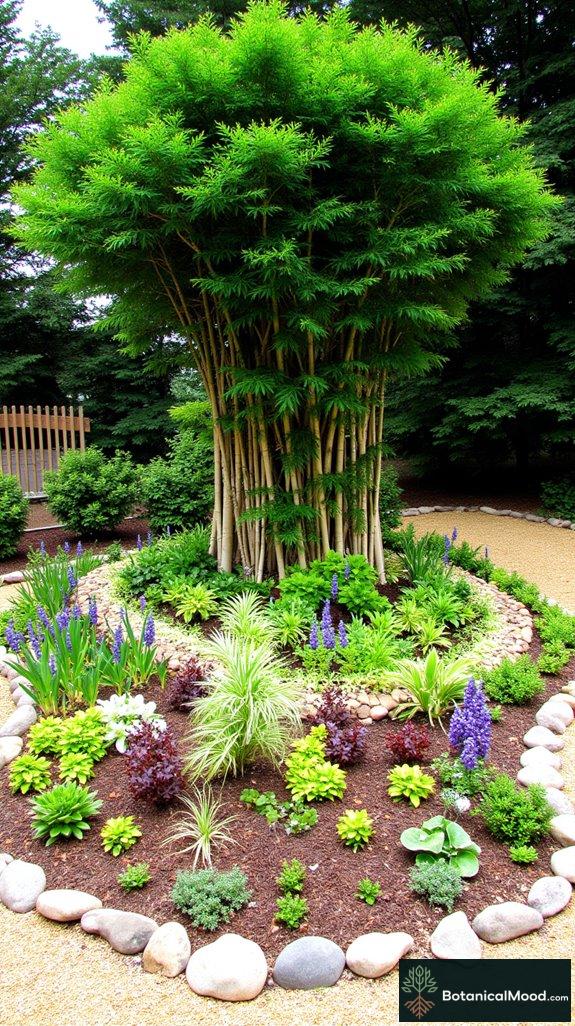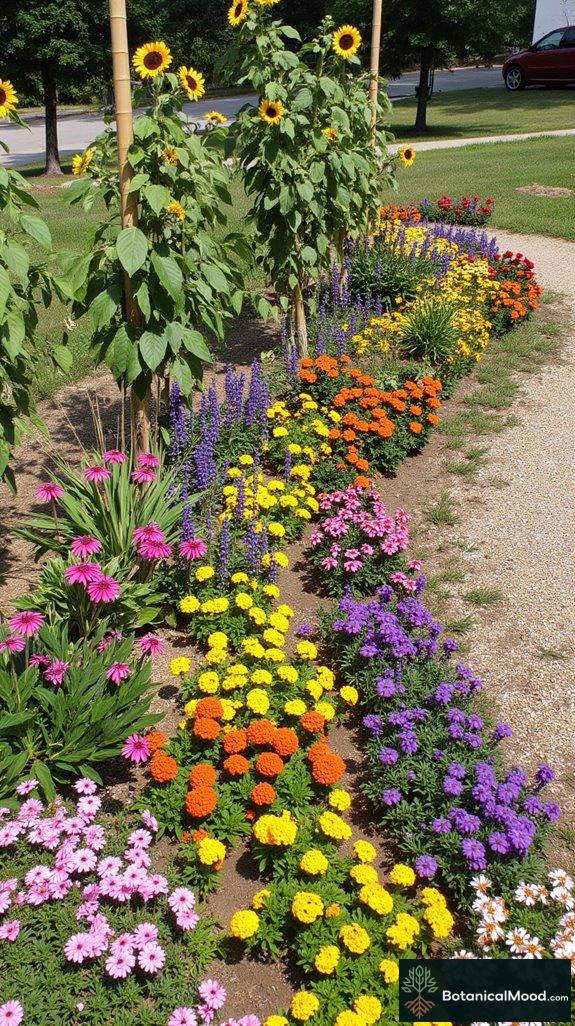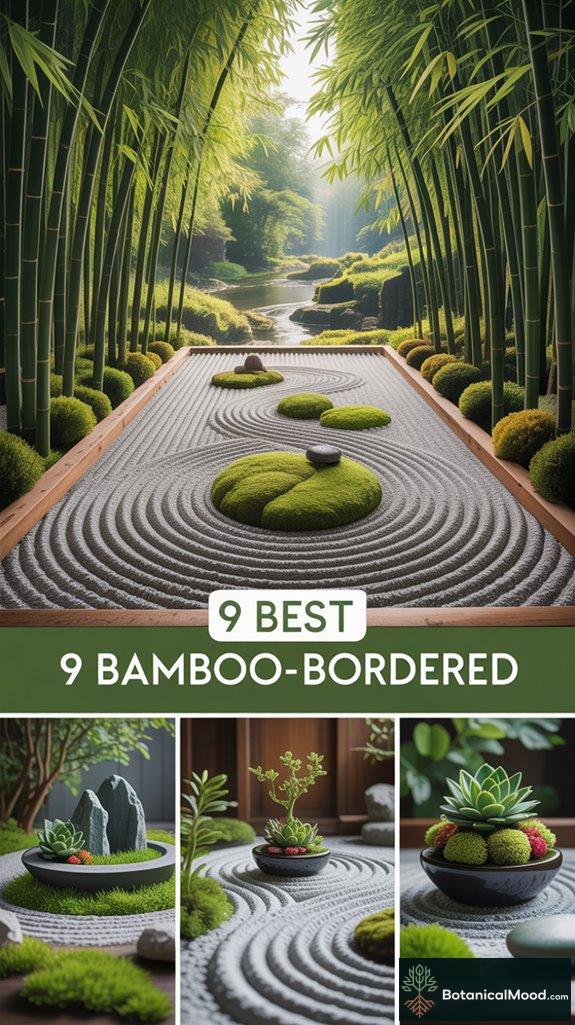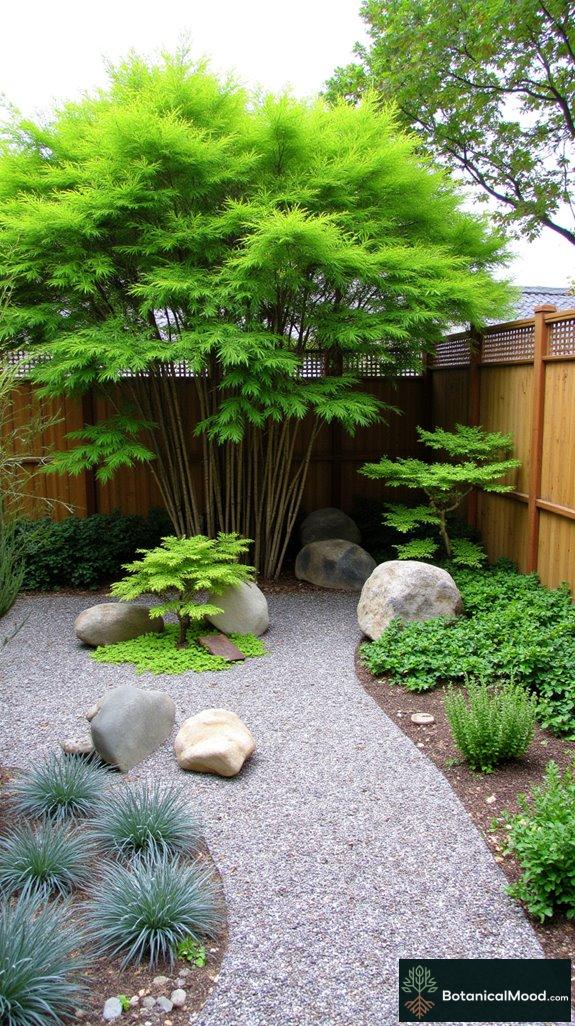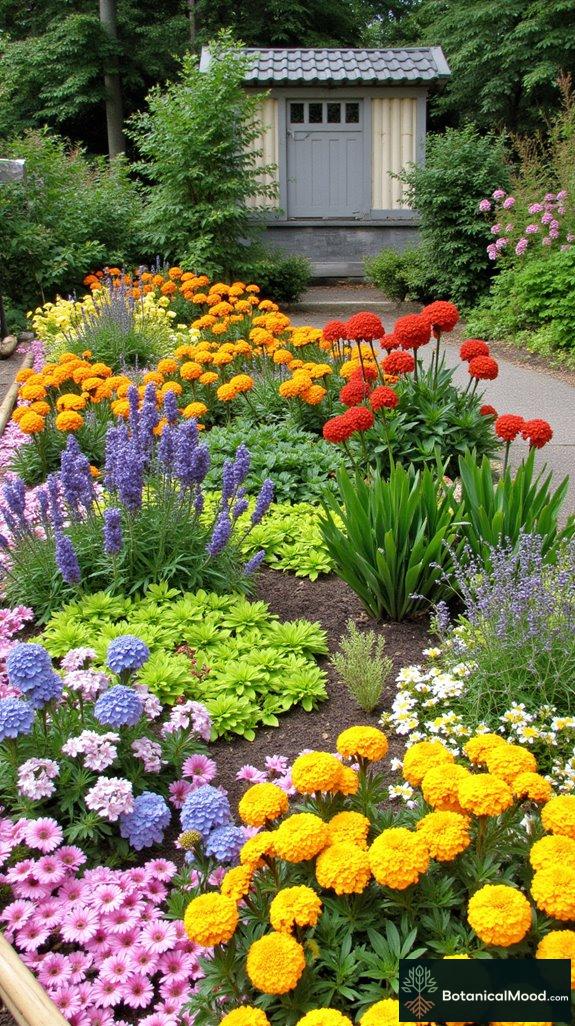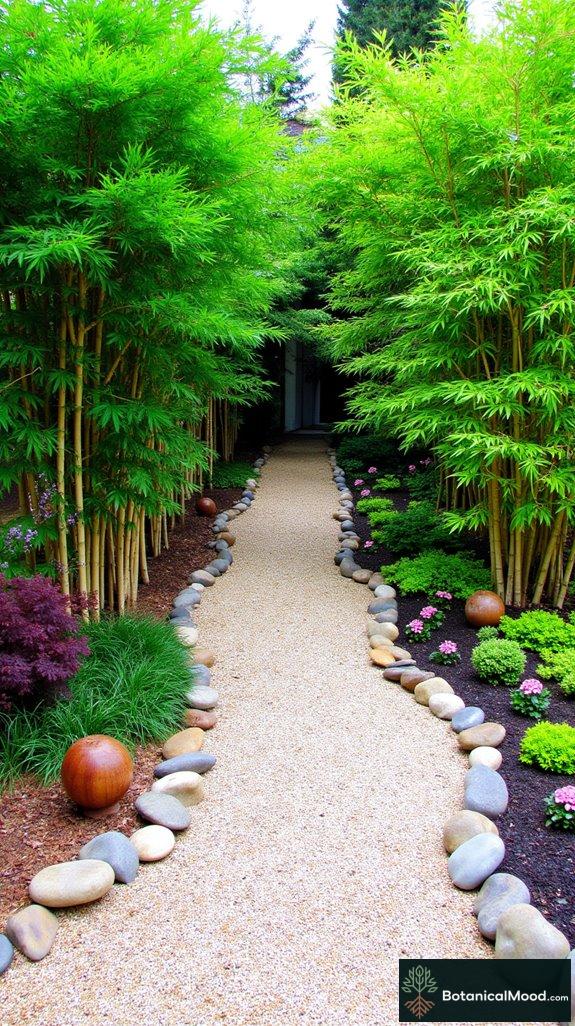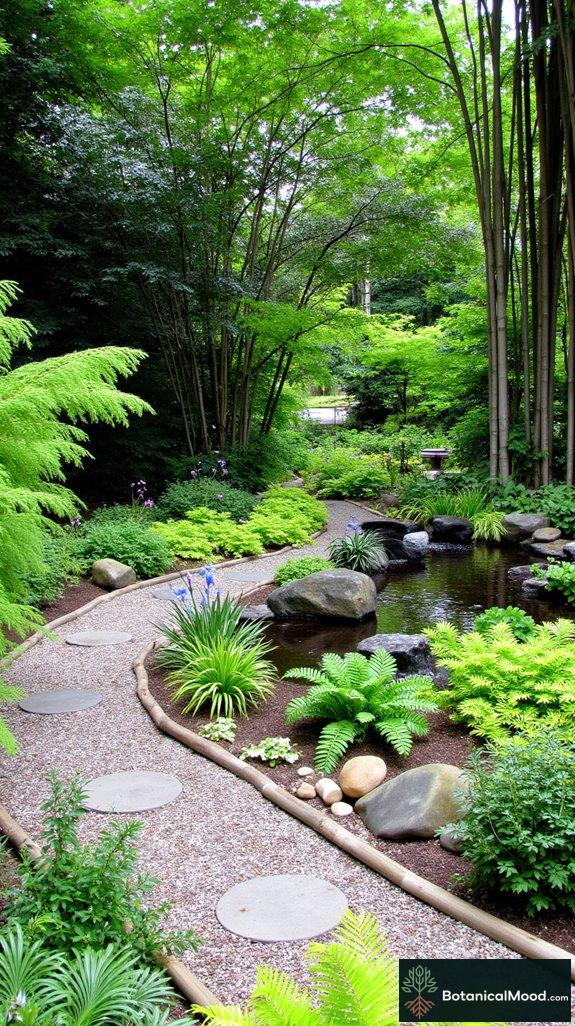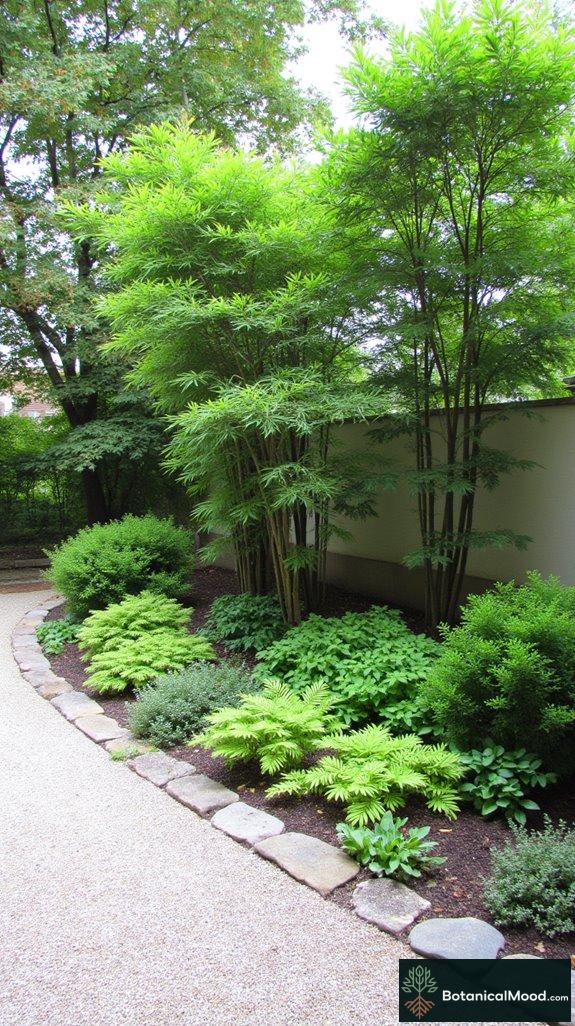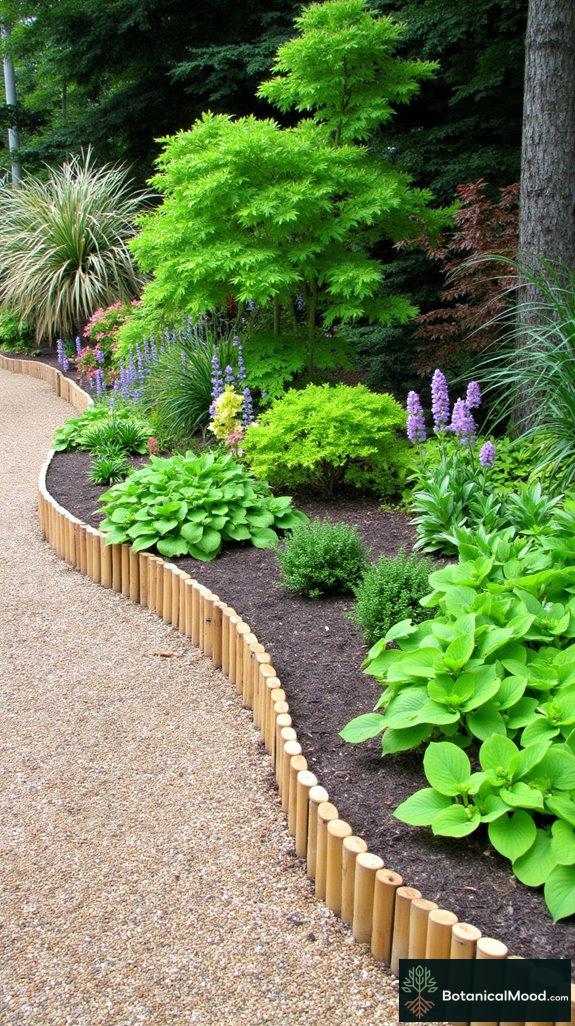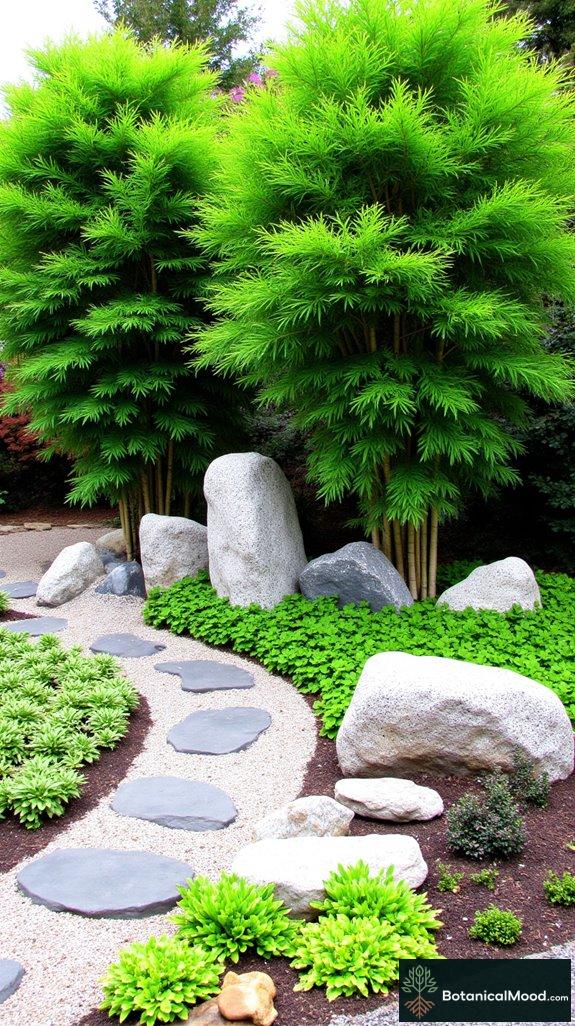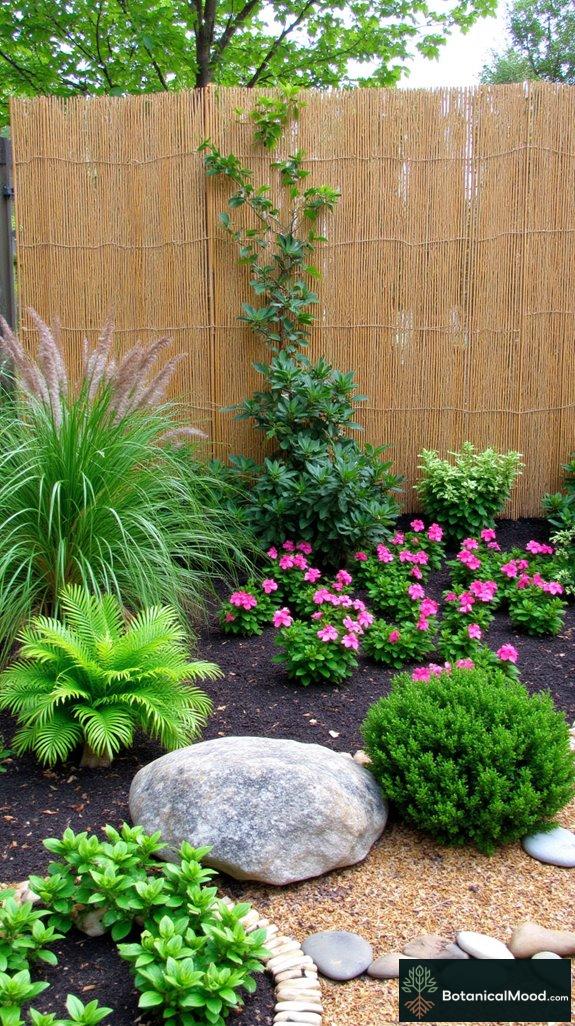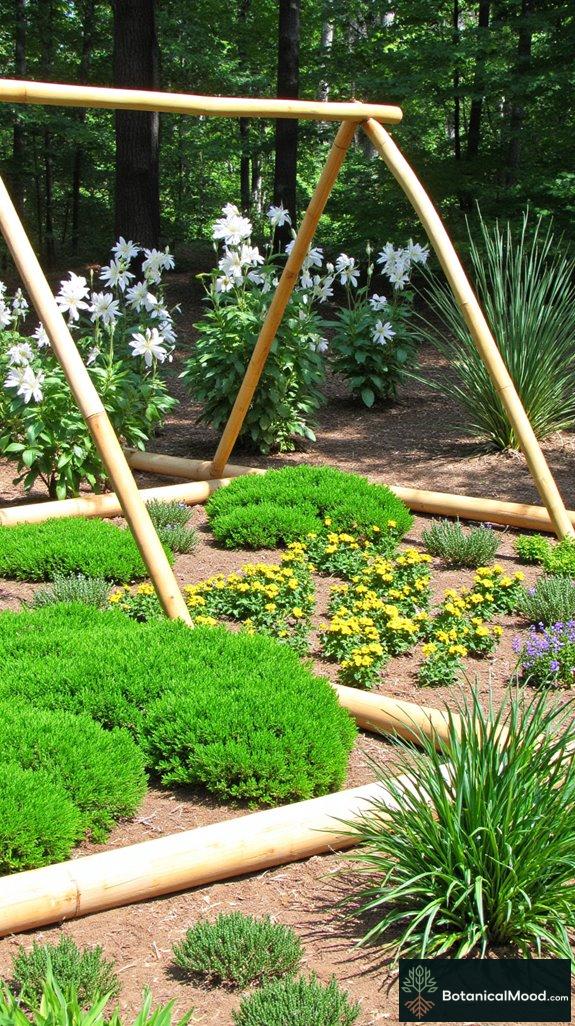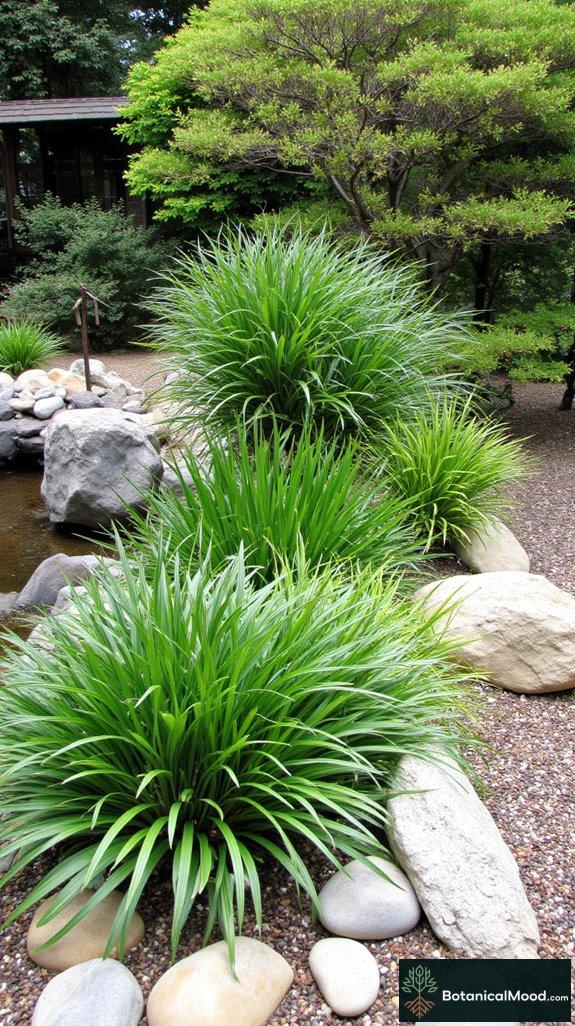Transform Your Space with Zen Bamboo Gardens
Ever wondered how to create a backyard escape that doesn’t require a trust fund? I’ve discovered the perfect solution: a Zen bamboo garden with five distinct zones.
My Tranquil Meditation Zone pairs smooth stones with whispering bamboo – because nothing says “calm down” like plants that grow an inch while you’re still deciding where to place them.
Serene Water Features became my obsession after installing a small pond with water lilies. The constant maintenance? Totally worth the Instagram likes.
For lazy afternoons, my Lush Seating Corner provides the perfect spot to pretend I’m actually going to meditate.
The Pathway of Reflection – where I mainly reflect on why I chose such high-maintenance plants.
Finally, my Herb and Flora Section combines useful basil with marigolds that somehow survive my notorious black thumb.
How My Disastrous First Garden Led to Zen Design Mastery
Let me share a garden trauma that still makes me cringe. Three years ago, I impulsively bought 27 different plant varieties for my first garden – with zero planning. The result? A chaotic jungle where aggressive mint declared war on my delicate flowering perennials.
This spectacular failure taught me the value of intentional design and spatial harmony. Now I sketch layouts before planting, considering mature plant heights, seasonal interest, and maintenance requirements.
My bamboo creates natural privacy screens while Japanese forest grass adds textural contrast. I’ve incorporated elements of wabi-sabi philosophy, embracing imperfection and transience in my garden’s evolution.
The most important lesson? Sometimes the best garden designs emerge from our biggest mistakes.
Quick Takeaways
- Tranquil Meditation Zone: A serene area for relaxation featuring natural materials, low-maintenance plants, and calming elements like pebbles and water features.
- Serene Water Feature Area: Central to the garden, includes a soothing water feature surrounded by smooth stones and moisture-loving plants, promoting sustainability.
- Lush Seating Corner: An inviting nook designed with bamboo and stone seating amidst lush foliage for comfort, enhancing the zen atmosphere.
- Pathway of Reflection: A beautiful gravel or stone pathway flanked by ornamental grasses and dwarf bamboo, encouraging contemplation and tranquility throughout the garden.
- Vibrant Herb and Flora Section: A colorful and functional area with diverse culinary herbs and seasonal flowers arranged in layers for visual interest and biodiversity.
Tranquil Meditation Zone

Tranquil Meditation Zone
A Tranquil Meditation Zone is a serene planting bed designed for relaxation and mindfulness, typically sized between 4’x4’ to 6’x6’.
Arrange the bed in a square or circular layout, using materials like natural stones, bamboo borders, or minimalistic wooden frames.
Incorporate soft, lush greenery, such as bamboo varieties, ferns, and ornamental grasses, alongside calming elements like smooth pebbles and a subtle water feature. This combination creates an inviting atmosphere for meditation, enhancing the overall aesthetic with light and airy elements.
Incorporate lush greenery and calming features to create an inviting atmosphere for meditation and tranquility.
Adding native woodland plants to your design can heighten the tranquility and create a more harmonious environment.
Selecting Plants for Your Tranquil Meditation Zone
When selecting plants, opt for varieties that promote serenity and have low maintenance requirements. Consider the following plants:
- Japanese Maple (Acer palmatum)
- Bamboo (Phyllostachys spp.)
- Peace Lily (Spathiphyllum)
- Ferns (e.g., Boston Fern, Maidenhair Fern)
- Ornamental Grasses (e.g., Blue Fescue)
Designing Your Tranquil Meditation Zone Planting Bed
To design an effective meditation zone, follow these tips:
- Choose a quiet, shaded location.
- Incorporate gentle curves, avoiding harsh lines.
- Use a mix of plant heights for visual interest.
Arrange plants with taller species like bamboo at the back or center, and shorter ones towards the front or edges, spacing them about 1-2 feet apart to allow for growth.
Pro tip: Cluster plants with similar watering and light needs to promote a harmonious environment.
Seasonal Care and Maintenance of Your Meditation Zone
Regularly water your plants, fertilize in spring, prune to shape in early summer, and monitor for pests throughout the year to maintain a thriving Tranquil Meditation Zone.
Serene Water Feature Area

The Serene Water Feature Area planting bed is an essential component of an elegant Zen bamboo garden. Typically measuring 4-6 feet in diameter, this circular or semi-circular layout surrounds a tranquil water feature, such as a pond or fountain. It provides a harmonious and soothing ambiance with an arrangement of lush plants. Incorporating xeriscape principles can enhance the sustainability of your water feature area while maintaining its aesthetic charm.
Key materials include smooth stones, soil, and mulch, which frame the water feature while maintaining a natural look. Recommended plants might include Japanese moss, water lilies, bamboo grasses, and hostas—each selected for their serene aesthetic and low maintenance.
How to Select Plants for the Serene Water Feature Area
When choosing plants, consider those that thrive in humid conditions and require minimal upkeep. Here are some excellent options:
- Water lilies (Nymphaea)
- Japanese moss (Hypnum)
- Bamboo grasses (Himalayacalamus)
- Hostas (Hosta spp.)
- Ferns (various types)
Designing & Planning Your Serene Water Feature Area Planting Bed
To design this planting bed, start by sketching a circular layout around the water feature. Tips for a harmonious arrangement include:
- Space taller plants (like bamboo) towards the back or center.
- Position shorter plants (like ferns) around the perimeter.
- Consider color contrast and textures for visual interest.
Pro Tips:
- Plant in clusters for a natural feel.
- Interleave plants for maximum growth space.
- Leave gaps for air circulation.
Seasonal Care and Maintenance for Your Serene Water Feature Area Bed
Throughout the year, maintain adequate watering, apply balanced fertilizer in spring, prune plants for shape and health, and monitor for pests regularly to uphold the beauty of your planting bed.
Lush Seating Corner

A Lush Seating Corner is an inviting nook within a Zen Bamboo Garden, typically about 6×8 feet. This area features comfortable seating surrounded by a harmonious arrangement of plants and natural materials.
Use bamboo and stone for seating, creating a serene retreat. The layout should incorporate lush foliage plants like ferns, hostas, and bamboo, combined with ornamental grasses for texture and movement. Incorporate natural stones or gravel to enhance the zen aesthetic. Additionally, bamboo-bordered garden beds help define the space and create a tranquil atmosphere.
How to Select Plants for Your Lush Seating Corner
When choosing plants, prioritize low-maintenance species that thrive in shaded or partially shaded environments.
Suggested plants include:
- Bamboo (Phyllostachys species)
- Japanese Fern (Athyrium niponicum)
- Hosta (Hosta spp.)
- Astilbe (Astilbe spp.)
- Liriope (Liriope muscari)
Designing Your Lush Seating Corner Planting Bed
To design your Lush Seating Corner, follow these tips:
- Plan the layout: Position seating centrally, surrounded by taller plants.
- Layer plants: Place taller species in the back, medium in the middle, and shorter in front.
- Space plants: Arrange them about 1-2 feet apart to allow for growth.
- Pro tips: Use odd-numbered clusters for a natural look and include hardscape elements for balance.
Seasonal Care and Maintenance for a Lush Seating Corner
Maintain your planting bed year-round by regularly watering, applying balanced fertilizer in spring, lightly pruning any overgrown plants in late summer, and monitoring for pests.
Pathway of Reflection
The Pathway of Reflection is a serene planting bed, typically measuring 4 feet wide by 20 feet long, designed to enhance the beauty of a Zen Bamboo Garden. Arranged symmetrically along a gravel or stone pathway, this planting bed offers an inviting and tranquil look.
Common elements include low-growing groundcovers, ornamental grasses, and strategically placed boulders or wooden elements for balance. Ideal plants include dwarf bamboo, ferns, and moss, while materials may involve weather-resistant stones and natural mulches to enhance drainage.
Selecting Plants for Your Pathway of Reflection Bed
When selecting plants for your pathway, consider textures, colors, and seasonal interest. Suitable plants include:
- Dwarf Japanese Black Pine
- Bamboo ‘Fargesia’ varieties
- Blue Fescue Grass
- Hosta ‘Blue Angel’
- Japanese Maples
Designing Your Pathway of Reflection Planting Bed
To design this planting bed, start with a vision of tranquility and balance.
- Layout Tips:
- Space plants 18-24 inches apart for growth.
- Group similar species to create rhythm and harmony.
- Use varying heights for visual depth.
- Pro Tips:
- Use taller plants at the back and shorter plants in the front.
- Incorporate curved edges for a more natural flow.
Seasonal Care and Maintenance of the Pathway of Reflection Bed
Regularly water deeply, fertilize with low-nitrogen fertilizer in early spring, prune dead growth in fall, and monitor for pests like aphids throughout the season.
Vibrant Herb and Flora Section
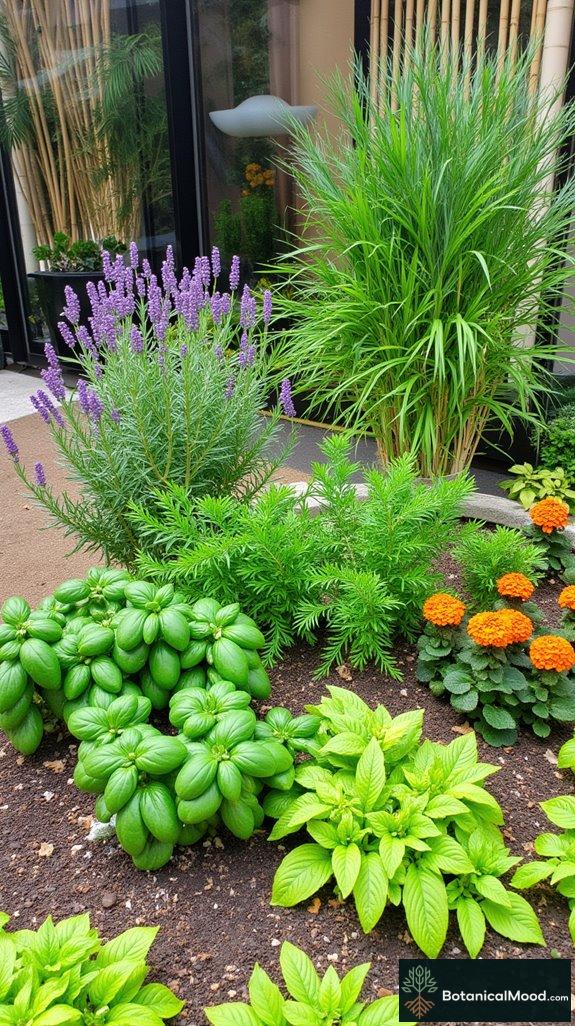
The Vibrant Herb and Flora Section is a fascinating planting bed designed for ideal growth and colorful appeal. Ideal dimensions range from 4×8 feet, allowing for a layered arrangement that accents the garden beautifully.
Use organic materials such as cedar wood for borders and rich, well-draining soil. Incorporate a mix of herbs like basil, rosemary, and chives, alongside vibrant flowers such as marigolds and nasturtiums for visual interest.
How to Select Plants for a Vibrant Herb and Flora Bed
When selecting plants for this garden bed, consider light requirements, growth habits, and seasonal interest. Here are some excellent choices:
- Basil (Ocimum basilicum)
- Rosemary (Rosmarinus officinalis)
- Chives (Allium schoenoprasum)
- Marigolds (Tagetes)
- Nasturtiums (Tropaeolum majus)
Designing and Planning a Vibrant Herb and Flora Planting Bed
To design this planting bed:
- Choose a sunny spot with at least 6 hours of sunlight daily.
- Plan a mix of perennial and annual plants for year-round beauty.
- Space herbs 12-18 inches apart for ideal air circulation.
- Position taller plants at the back and shorter ones towards the front for visual layers.
Pro Tips: Use companion planting technique for pest control, and consider planting herbs near flowers to enhance pollination.
Seasonal Care and Maintenance of the Vibrant Herb and Flora Bed
Throughout the year, maintain regular watering, apply organic fertilizers in spring, prune herbs after flowering, and monitor for pests using natural control methods.
FAQ
What Types of Bamboo Are Best for a Zen Garden?
I find that golden bamboo and black bamboo are perfect for a zen garden. Their contrasting colors create a calming atmosphere. Embracing them brings peace and liberation, inviting tranquility into your outdoor sanctuary.
How Do I Maintain Bamboo in a Garden Setting?
Keeping bamboo’s wild spirit in check requires regular pruning and diligent pest control. I’ve found that gentle trimming promotes growth and health, allowing me to enjoy its tranquility without chaos encroaching on my serene garden haven.
Can a Zen Garden Be Created in Small Spaces?
I’ve created Zen gardens in small spaces, finding that they offer incredible peace and balance. Using small space solutions, I embrace minimalism while enjoying the calming benefits that a compact Zen garden provides.
What Design Elements Enhance the Tranquility of a Zen Garden?
To create tranquility, I focus on sound elements like gentle water features and wind chimes, while embracing visual simplicity through carefully placed stones and sparse vegetation. This harmony liberates the spirit and nurtures inner peace.
Are There Specific Colors That Promote Relaxation in a Zen Garden?
Yes, earthy tones like greens and browns truly promote relaxation in a zen garden. I believe color psychology plays a huge role in garden aesthetics, guiding us toward a peaceful, liberating atmosphere for our minds.
Summary
I’ve designed my zen bamboo garden with five distinct sections. My meditation zone and seating corner offer peaceful retreats, while my water feature creates soothing ambiance. The reflection pathway guides my thoughts, and my herb section delivers both beauty and function. Each element brings me balance.
Have you created your own zen space? I’d love to hear how your garden helps you find tranquility in your busy life.
Share photos of your bamboo garden design! What creative elements have you incorporated? Your unique approach might inspire our community to transform their outdoor spaces.
